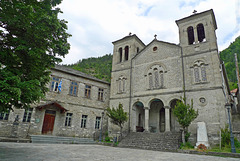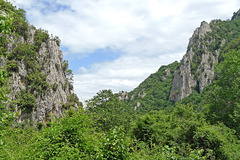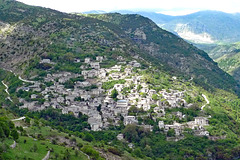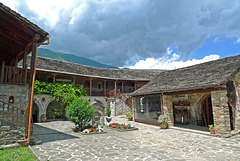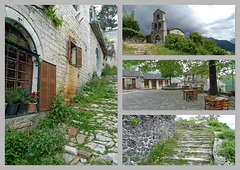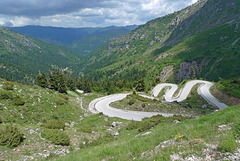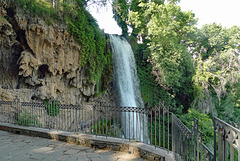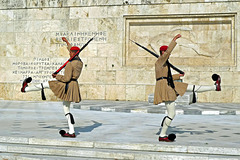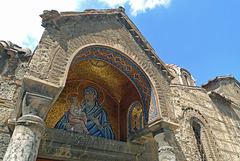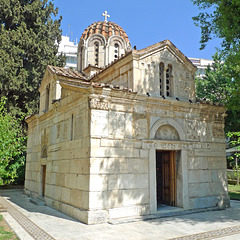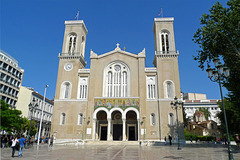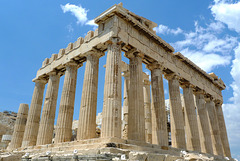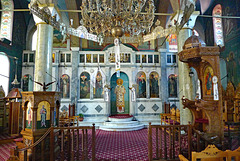Jaap van 't Veen's photos
Greece - Pyrsogianni, Church of St George
| |
|
|
|
The new Church of St George was built in 1903-1905, after the old church - dating back to the year of 1712 -with the same name was demolished. Although rather ‘young’ the church has a beautiful interior with remarkable pillars, some chandeliers and a woodcarved iconostase.
The Church of St. George was built according to the standards of the Cathedral of Athens, with voluntary work of craftsmen of the village, while the basic cost of the construction was covered by the contributions of people coming from Pyrsogianni from all over the world.
Greece - Pogoniskos/Boútsikon
| |
|
|
|
On our car journey from Molyvdoskepastos - close to the Albanian border - to Konitsa, we found ourselves on a very narrow road through a pristine stretch of nature. It was impossible to turn around and we had to drive on to the very tiny hamlet of Pogoniskos with just a couple of inhabitants. That had the advantage of taking us past a countless number of 'carpets' of wild flowers in all sorts of colours and shapes (see PiPs). The valley was enclosed by rugged cliffs.
Greece - Syrrako
| |
|
|
|
Syrrako is a beautiful and picturesque village, which impresses with its grey stone houses that are perched on a steep slope of Mount Peristeri on an altitude of 1.200 meters. The ‘fairytale’village – located in the heart of the Tzoumerka region - is declared to be a traditional settlement. The village offers stone houses with slate roofs, cobbled alleys, churches, watermills, stone fountains, which are creations of renowed craftsmen.
Syrrako was built by Greek Vlach speakers in the 15th century. Around the year of 1480 the village along with other villages in the area, went under the Ottoman domination but managed to secure a privileged tax treatment and some kind of autonomy. Syrrako and neighboutring Kalarrytes were the only villages of Epirus that took part in the Greek Revolution from the first years. During that period, the village was looted and burnt down by the Turks and the inhabitants abandoned it, trying to save their lives. They returned in the year 1825 and rebuilt Syrrako.
Greece - Monastery of Panagia Molyvdoskepastos
| |
|
|
|
The history of the Monastery of Molyvdoskepastos goes back in the Byzantine era and was originally built in the 7th century. It is one of the oldest monasteries in Greece. Its founder was the Byzantine emperor Constantine IV Pogonatos. The monastery was renovated in the 14th century by Andronikos Komnenos Doukas Palaiologos. The monastery owes its name from the lead roof it once had: i>molivdoskepasti means “with a roof of lead”. The lead was stolen by Turks to make bullets and was then replaced by slates.
The katholikon (main church) belongs to a complex architectural style and was built in three phases. The original church with three vaults and a dome, was the first to built (11th and 12th century). The middle cross vaulted section was added at the end of the 13th century and in the beginning of the 14th century. Finally, an open narthex was added in the year of 1521 by the inhabitants of a nearby village. The interior of the church is decorated with splendid wall and ceiling paintings of the 14th and 16th centuries. The iconostasis is carved, probably dating back to the 15th century with remarkable icons.
After 1913 the monastery remained without monks, its properties were encroached and its holy artifacts and relics were stolen. In 1943, when the area was bombarded by the Nazis, it was almost razed to the ground. In 1988 the monastery was manned once more by the present day brotherhood.
From the outside the monastery looks (a little bit) like a fortress, due to its walls and gatehouse (PiP5). It is located about 20 km from the town of Konitsa, some hundred meters away from the Aoos River and the border with Albania.
Greece - Kalarrytes
| |
|
|
|
Kalarrytes (Kalarrites/Kalarites) is one of the most beautiful villages of Greece. Its houses are built according to the traditional Epirotic architecture. The village boasts beautiful stone bridges, cobbled roads, stone houses with traditional schist roofs, old drinking fountains and watermills.
The village - like neighbouring Syrrako - was built in the 14th and 15th centuries by Vlach pastors. The Vlach inhabitants, having secured special privileges and the protection of the Valide sultan. Thanks to their sharp business acumen, helped the village grow through the trade of not only agricultural products, but also the particular goods in which they specialized. The silversmiths of Kalarrytes were known for quality craftsmanship. The family Voulgaris is very well known; one of them moved to Roma in the 1880s and opened a store that would become the famous brand Bulgari.
Kalarrytes - surrounded by the imposing mountains of Tzermouka - lies at an elevation of 1200 meters and is sometimes called the ‘Eagles’ Nest of Epirus’.
Greece - Tzoumerka
| |
|
|
|
Tzoumerka - also called Athamanika - is a mountainous region in northwestern Greece, between Ioannina, Arta and Meteora. Its highest point in Tzoumerka – part of the Pindus mountains - is the mountain Katafidi with 2.393 meters.zoumerka. The region is not very well known, yet offering an “earthly paradise”, picturesque villages, extraordinary monasteries, surrounded by gorges, rivers and steep mountains.
Tzoumerka has a low population density with just some smaller villages. Forests dominate the low-lying areas of the mountain; grasslands, shrubs and barren rocks the higher elevations.
The name Tzoumerka seems to be of Vlach origin, as “tzoum” in the language of Vlachs means the “steep peak”.
We took a drive through the most rugged and remote part of Tzermouka: Metsovo - Syrrako. This was one of the most challenging and exciting road trips we have ever driven. Imagine a narrow road - barely wide as a car - full of small and even large boulders, sometimes a partially eroded road surface (PiP4). That road winds steeply through the landscape with many hairpin bends. To make matters worse, we also faced fog for much of the drive. After the hamlet of Chaliki, the road improved to reach an altitude of almost 2,000 metres - sometimes with snow on the roadside. With a countless number of curves, we finally reached Syrrako. With that, this Greek adventure came to an end.
Greece - Edessa, waterfalls
| |
|
|
|
The Edessa waterfalls - Greece’s largest waterfalls - are quite exceptional. Centuries ago people made a bassin for their water supply, but in the 14th century the river changed it course ((perhaps after a geologic or weather phenomenon) creating first one waterfall but later on several other small waterfalls.
The most impressive waterfall - called Karanos - has a height of 70 meters. The smaller twinfall is called Lamda. It is possible to walk behind the big Karanos waterfall where one has a perfect view with a water curtain (PiP 4).
Greece - Athens, changing the guard
| |
|
|
|
Greek guards or “Evzones” - also known as “Tsoliades” - are members of the Presidential Guard found outside the Hellenic Parliament. They have become synonymous with the city of Athens and were originally founded in 1868 as a regiment of the Greek army. It is a high honour for a soldier to be selected to join the “Evzones”.
They guard the grave of the Unknown Soldier that represents the common memory of all unknown soldiers killed at war. The changing of the Greek guards occurs every day at the top of the hour.
The “Evzones” are required to stand guard mute and expressionless for 60 minutes at a time, and are harshly punished if they succumb to the tantalizing efforts of tourists from all over the world to break their concentration.
Greece - Athens, Church of Panagia Kapnikarea
| |
|
|
|
The Church of Panagia Kapnikarea (Εκκλησία της Παναγίας Καπνικαρέας) is one of the oldest churches in Athens. It is located on the heart of the cty along an important shopping street. In 1834, after Greece had regained its independence and Athens, as the new capital, was in the midst of rebuilding, town planners had resolved to either demolish or relocate the church to ensure a thoroughfare for horse and carriages. The church had caught the eye of King Louis of Bavaria (father of the newly appointed King Otto of Greece) as an important landmark and together with the Metropolitan Bishop of Athens, ensured the street was designed with the church in place.
The church of Panagia Kapnikarea is a small Byzantine church dating from the 11th century. It was erected on an old church of the 5th century, itself built on a Greek temple. The church now belongs to the University of Athens and is also d "Church of the Sacred University".
The church’s name is linked with the family name “Kapnikares” and refers to the official charged with collecting tax on tobacco during the Byzantine period. It was formerly known as “Kamoucharea” from the word “kamoucha”, which means fabrics that are interwoven with gold, referencing the many textile workshops in the area.
Greece - Athens, Anafiotika
| |
|
|
|
The history of the charming neighbourhood of Anafiotika goes back to the mid-1800s. Greece needed workers to transform the new capital. Carpenters and masons from the island of Anafi (and other areas) came and took over this rocky terrain. They took advantage of the Ottoman law that stated a property belonged to you if you could build it between sunset and sunrise.
Anafiotika is a gem island-like oasis. Perched on the back of the Acropolis, the Anafiotika neighbourhood offers narrow, winding, shady streets with flowers and cats and views of the city. The narrow streets are lines streets with small white-washed osland-style houses. It looks like a village lost in time, filled with bougainvillaea, jasmine and other plants.
Greece - Athens, Little Metropolis Church
| |
|
|
|
The Little Metropolis (Μικρή Μητρόπολη), formally the Church of St. Eleutherios (Άγιος Ελευθέριος) is a Byzantine church located next to the large Metropolitan Cathedral of Athens ("Great Metropolis") .
The Little Metropolis Church - measuring just seven by eleven meters - is one of the smallest churches in Athens, but is also considered one of the oldest and most beautiful. It was built on an old temple - most probably in the early 13th century - and was mainly used for intercessions by pregnant women. Before the Great Metropolis Church was built, it was even a bishop's church.
Greece - Athens, Metropolitan Cathedral of the Ann…
| |
|
|
|
The Metropolitan Cathedral of the Annunciation (Καθεδρικός Ναός Ευαγγελισμού της Θεοτόκου), popularly known as the Great Metropolis is the cathedral church of the Archbishopric of Athens and all of Greece.
On Christmas Day, 1842 Greek King Otto and Queen Amalia laid the the first cornerstone of the Metropolitan Cathedral of Athens and thus commenced its construction. Workers used marble from 72 demolished churches to build the cathedral's immense walls. Three architects and 20 years later, it was completed. On May 21, 1862, the cathedral was dedicated to the Annunciation of the Mother of God.
The cathedral is a three-aisled, domed basilica that measures 40 meters long, 20 meters wide and 24 meters high. It features two bell towers and an impressive dome. The interior of the church is decorated with numerous frescoes; the impressive iconostase dates from 1825.Inside are the tombs of two saints killed by the Ottoman Turks during the Ottoman period: Saint Philothei and Patriarch Gregory V.
The Cathedral is a significant landmark in the Greek Orthodox Church and remains the largest church in Athens. Today it is the main church in Athens and also serves as the archbishop's seat.
Greece - Glyfada, Cathedral of Saints Constantine…
| |
|
|
|
The cathedral was built in 1934 and is the only one in Greece with a ‘rotunda dome’ and four semi-domes. Some years ago the temple was renovated and the paintings were replaced with mosaics. Nowadays the church is one of the most beautiful and majestic in the country.
Greece - Athens, Acropolis > Parthenon
| |
|
|
|
The Acropolis of Athens, or the “Sacred Rock” as it is called, is considered the ultimate symbol of ancient Greek civilization and culture. The Acropolis rock -156 meters above sea level - is considered a landmark for Athens, with its history linked to religious festivals, myths and struggles throughout the centuries. Since 1987 it has been a monument protected by UNESCO as a cultural site.
The Parthenon is the most characteristic and famous monument of the Acropolis. It was built on the ruins of a former temple in 447 BC, as part of a plan to rebuild the temples of the Acropolis after their destruction by the Persians in 480 BC. The construction of the building was completed in 438 BC, while the last decorative statues were added in 432 BC.
The Parthenon, built in honor of the goddess Athena, is 70 meters long (17 columns), 31 meters wide (8 columns) and 19 meters high. Its style is Doric, but also shows elements of Ionic style.as shown in the frieze. The material used for its construction is marble from Mount Pentelikon.
Greece - Athens, Acropolis > Erechtheion
| |
|
|
|
The Acropolis of Athens, or the “Sacred Rock” as it is called, is considered the ultimate symbol of ancient Greek civilization and culture. The Acropolis rock -156 meters above sea level - is considered a landmark for Athens, with its history linked to religious festivals, myths and struggles throughout the centuries. Since 1987 it has been a monument protected by UNESCO as a cultural site.
The Erechtheion (or Temple of Athena Polias), located on the northern side of the Acropolis, was built between 421 and 406 B.C., but was actually completed in 395 B.C., due to interruptions caused by the Peloponnese Wars. It is a replacement of an earlier temple dedicated to Athena Polias. The name derives from Erechtheus, the mytical king of Athens, who was worshipped there.
The Erechtheion consists of several sacred sites, all under one roof. These include a church, a palace and a harem. This structure has a rather complicated layout when compared to others on the Acropolis. There are shrines inside dedicated to Athena and Poseidon, who fought for the city, as well as to the two legendary Kings of Athens, Erechtheos and Kekrops.
The Erechtheion is known mainly through its porch, its colums instead of pillars had six maidens - two meters in height - known as the “Caryatids”, that support the roof. In 1811 one of them was brought to England (now in the British Museum); the remaining five were replaced by replicas to prevent further damage from the smog (nowadays the originals are in the Acropolis Museum).
Greece - Karpenisi, Holy Church of the Virgin Mary
| |
|
|
|
The Holy Church of the Virgin Mary (Ιερός Ναός της Παναγίας) is one of the five large churches in the the town of Karpenisi. The Virgin Mary Church was the cathedral during the Turkish occupation. In July 1821 all churches were destroyed and/or burned down.
After the burning of the churches and the whole town of Karpenisi by the Turks in 1821, the people began to settle down again. Their primary goal was to rebuild their churches and school. Each parish was interested in its own hurch and was doing an enviable activity. The present Holy Church of the Virgin Mary was built in 1910 and it is the fourth time that the church has been built on the same site.
Greece - Preveza, Metropolitan church of Saint Cha…
| |
|
|
|
The Metropolitan church of Saint Charalambos (Agios Charalambos) was built between 1715 and 1717 - when Preveza was still under Ottoman occupation - on the location of an older church. It is built in the style of a single-space basilica, but the later interventions and additions have changed its initial shape. On the eastern side they have walled-in a Roman sarcophagus from Nicopolis, in order to be used as a fountain. On the south-eastern side of the church, a later dated tower-shaped bell tower has also been added.
The painted decorations of the temple include great oil-paintings which cover the side walls and the wooden roof. These paintings are copies of religious works of art by great European artists. Of exceptional quality is the wooden-carved iconostasis of the church, which was constructed by a craftsman from Epirus in 1827 and was gold-plated in 1836. The pulpit, the archieratic throne and some of the portable icons are also of great artistic value.
The church is located - a little bit hidden by the Venetian tower - at the pedestrian zone of the historical center of Preveza (PiP3).
Greece - Lefkada, Faneromeni Monastery
| |
|
|
|
Faneromeni Monastery - the most important religious center on the island of Lefkada - was built in 1634 on the site of an ancient temple dedicated to Artemis, the goddess of hunt, forests and animas. On this site, the students of Apostle Paul had preached Christianity some centuries ago.
In the Venetian times, particularly in the 18th century, the monastery was renovated, but unfortunately, two fires burnt it down. In the late 19th century the monastery was rebuolt in its current state. Today, it hosts an interesting Ecclesiastical Museum with rare Byzantine icons, paintings, carvings, handwritten manuscripts and other religious relics.
The monastery is located on a hill above the town of Lefkada and offers great views to the village and the northern side of the island PiP5).
Jump to top
- ipernity © 2007-2024
- Help & Contact
|
Club news
|
About ipernity
|
History |
ipernity Club & Prices |
Guide of good conduct
Donate | Group guidelines | Privacy policy | Terms of use | Statutes | In memoria -
Facebook
Twitter

